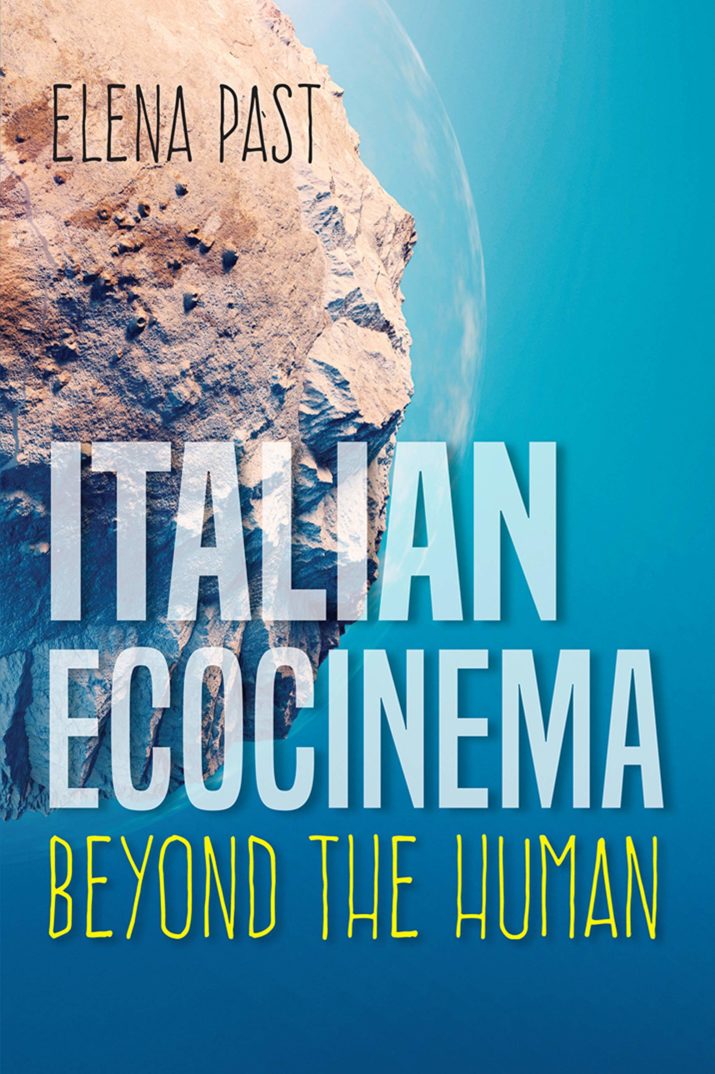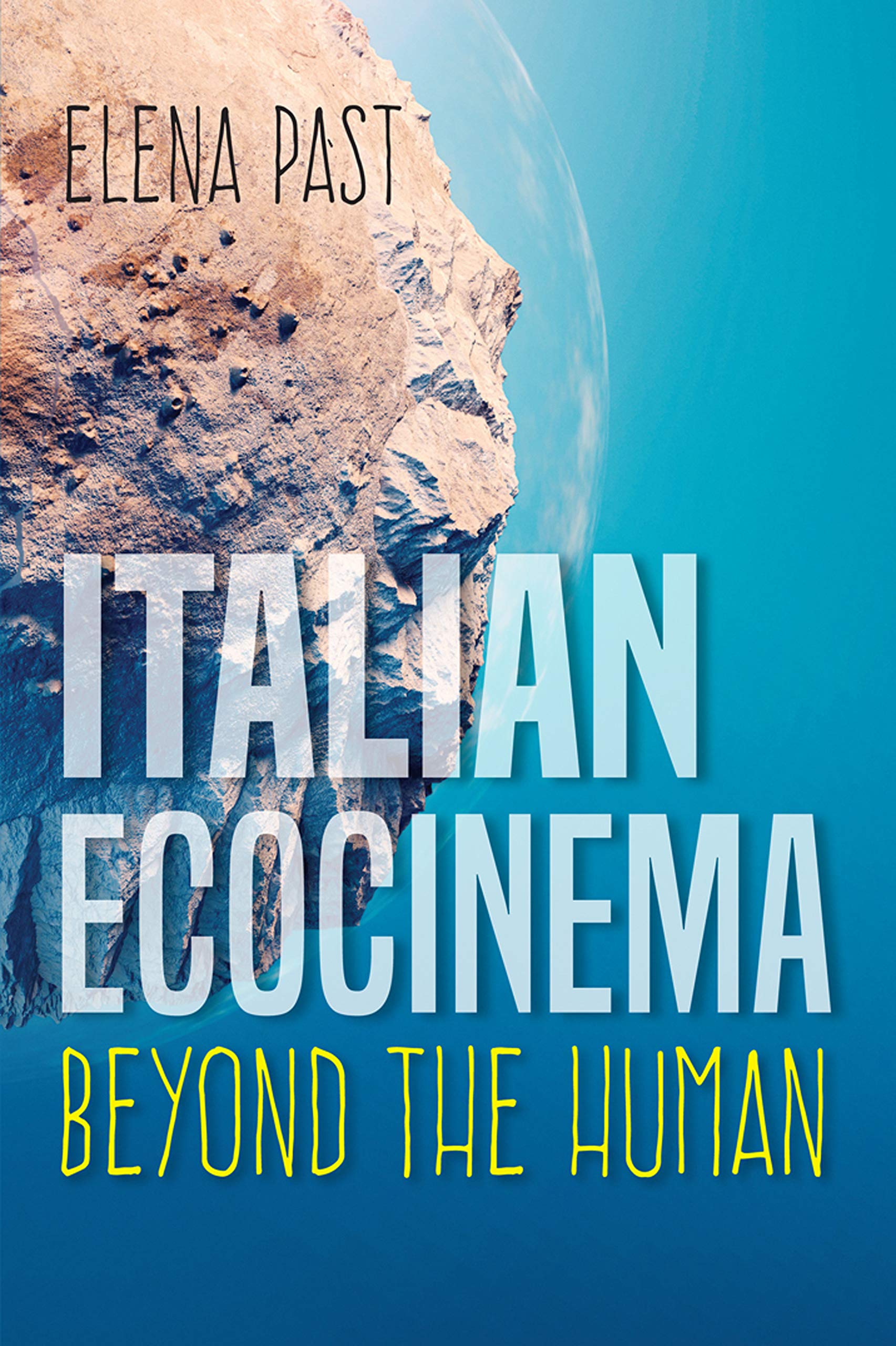

Elena Past’s Italian Ecocinema, published by Indiana University Press in 2019, opens the door of Italian media studies into an inter-disciplinary conversation on ecocriticism and film. “In short, this book seeks to uncover cinema’s ecological footprint, or the way a film shapes the world, while also seeing the reciprocal ways the world writes itself on film.” (Past 2) In Past’s preface, the reader is greeted with a warm, careful voice, which takes time to introduce the multi-faceted text so that one does not lose their way. The book analyzes five films and references even more academic disciplines, including history, industrial economics, oral memoir, acoustics, environmentalism, chemistry, geology, socio-economic politics, culinary studies, and more. Past writes: “I attempt an ethical path… an opening of Italian screen studies to “otherness,” and nonhuman actors in particular.” (Past 3) She embraces slowness in her analysis, leaning into the dis-anthropocentric lessons of listening and connectedness, absorbed from her incredibly thorough research.
Past’s exploration crosses five Italian films, each with its own chapter and ecocritical lens: Deserto rosso (Red Desert, dir. Michelangelo Antonioni, 1964), Gomorra (Gomorrah, dir. Matteo Garrone, 2008), Il vento fa il suo giro (The Wind Blows Round, dir. Giorgio Diritti, 2005), Le quattro volte (dir. Michelangelo Frammartino, 2010), and Fughe e approdi(Return to the Aeolian Islands, dir. Giovanna Taviani, 2010). The five distinct case studies engage with different ecocritical concept(s) (such as dirty theory, de-centralized acoustic landscapes, and toxicity). I noticed right away that all the films but for Red Desert are from the 2000s. Italian Cinema courses rarely arrive in the twenty-first century, with most Italian Film Studies (when included at all in American syllabi) ground themselves in neo-realism (neorealismo) of the 1930s and 40s, and the Golden Age of the 1950s and 60s. In this vein, Past’s media study reflects a contemporary Italy—one that listens to and critiques filmmakers and crew members in production today. Past side-steps from the traditional Italian film canon, perhaps nodding to the ecocriticism of her own analysis, begging to de-centralize cinema studies from the typically loudest actors (think of La dolce vita, Ladri di biciclette, or Roma città aperta).
Of course, Red Desert is arguably one of the first Italian films that diegetically and self-reflexively discusses the entanglement between the ambiente (as surroundings or environment), the human, and cinema. Certainly, plenty of other more “popular” films bring attention to ecocriticism, especially as the earliest Italian concerns for the environment were in the 1950s. As Past often clarifies, these initial movements were focused on conservation, which only transitioned into anti-pollution campaigns in the 1960s. However, Italian cinema is so incredibly rich that directors and screenwriters have incorporated the voice of the ambiente before Red Desert. What would Past’s thoughts be on a film like Paisà (dir. Roberto Rossellini, 1946), a six-episode vignette traversing WWII-ridden Italy, from Sicily to the Alpine Po delta? Past’s anthology is whole and extensive, but potentially still germinal.
The selection of films itself is notable in a few other ways. Firstly, one of five films was directed by a woman. A huge part of both anthropocentric and environmentalist thought considers point of view. While Past does not explain how she selected her menu of films, she cites countless authors of varying backgrounds and expertise, successfully incorporating the voices of many women scholars into her conversation. When listening in particular to the voices of filmmaking, Past listens to crew members and directors alike in extensive interviews. Past herself travels all around Italy geographically, smartly localizing her themes of interconnectedness, weaving a conversation in which she both listens and speaks.
Secondly, all but one film was produced solely in Italy, with Le quattro volte co-produced in Italy, Germany, and Switzerland. Of course, the book aims to discuss Italian cinema, but it is important to note the globalized film industry, especially with regards to recent productions. The soft power of media, including film, has tremendous influence, and international collaborations are not only becoming more commonplace but also competitively beneficial. (This is particularly so with the rise of “streaming.”) And finally, all films were either filmed entirely or produced on celluloid film. The filmmaking’s stake in the living world is high, even though its very own making is often contributing to or complicit in that world’s destruction. None of these comments intend to imply any misjudgments but are simply observations. In the effort to slow down the unsustainable isolationism of modern industry, self-awareness is key. Past is generously vulnerable with the reader, often reeling in her assertions with an almost feminist/queer acknowledgment that her perspective is but one of many: “Respecting the environment means understanding that you cannot live the same way in one place as you do in another.” (13)
Language is a powerful tool of agency. Italian philosopher Antonio Gramsci theorized a “subaltern,” a group excluded and denied agency by a hegemonic power. Philosopher Gayatri Chakravorty Spivak later famously questioned, “can the subaltern speak?” or, in other words, can those without power tell their own stories? Perhaps a Gramscian lens could really support Past’s arguments had she decided to include a more explicit socio-political and -economic lens. She touches upon this mostly regarding Gomorrah but also in The Wind. Garrone’s production team in particular intertwined with actual disenfranchised residents of Naples’ Le Vele housing, whom offered hospitality in the form of toilets and helping hands, amongst other things. Past points out how the filmmaking relied on the ambiente and the typically unheard voices, as much as they “found voice” in the film’s making. Past successfully highlights the ways in which the films lifted the voices of nonhuman actors, and ontologically as well as materially wrestles with storytelling through film.
Stacy Alaimo’s theory on trans-corporeality, Past shares (Past 81), asserts that the fates of all are intertwined. People like polluting industrialists, neo-capitalist managers, and ecomafiosi instead contribute to a narrative of individualism, disconnectedness, and the logic of profit. Past draws from Slow Food founder Carlo Petrini who refers to the reckless self-serving behavior as the “tyranny of urgency” as it refuses to acknowledge interdependence let alone relationships (Past 77). Slowing down, Past offers the reminder that establishing binaries in itself cannot acknowledge the complexity inherent in the world (another facet of trans-corporeality). All details of cinema are intertwined with the ambiente, simply seen in the celluloid film made from living carbon matter.
Past references theoretical sources from a wide range of disciplines, compiling a thorough analysis that also begs to be better grounded. Deciding to divide the book into film-focused chapters, Past does not really allow the films to talk to each other (except for mentioning Garrone’s Antonionian visual aesthetics). This is, of course, perfectly fine, as the book’s objective was clearly aiming to see how each film reconciled its own ambiente and vice versa. However, with this organization, the ecocriticisms of each film have a hard time dialoguing with each other, and so the reader is walking down an unfamiliar street in a familiar city: able to follow along and consider what information is presented, yet unexpectant of the details of that information, or why they are there in the first place. In short, it would be interesting to know why Past highlights the tempi morti, of one film, and the geological history of the land from another film. Understandably, not every film touches upon the other concerns addressed in the rest of the book. For example, the heavy use of dialect in Gomorrah speaks to a use of sound dissimilar to the absence of dialogue (spoken words) in Le quattro volte: one localizes and grounds, while the other de-centralizes and opens, and both contribute to each film’s eco-awareness. Additionally, the discourses in this book were also grounded in interviews, during which a variety of spur-of-the-moment observations could have been spoken or heard. The inclusion of interviews (both in the research and in the book) does also nicely disperse the speaking authority’s genre; individuals recounting their experiences balances out more abstract theory or sociological anticipations.
Past is admirably transparent. The epilogue and introductory chapters are written almost as memoirs, and also her voice is very clear throughout the book as a whole. A part of the ecocritical approaches of the films in question is precisely to acknowledge the human voice as one of many, rather than a) hyper-prioritizing the human voice, or b) ignoring the presence of the human voice, both of which subsequently consider it irrelevant to critique. Past does not pretend that her voice is radically more important than any other, demonstrated in her engagement with production members in interviews at various locations, for example. Additionally, she does not mute her voice or feign that she does not have a point of view, as demonstrated when she pushes against a purist or sterilized ecocriticism in favor of “getting her hands dirty” in Chapter 2. Past’s ecocritical analysis is apparent in both her conclusions on the films in question, but also in her own writing as a scholar.
Italian Ecocinema is a curious pedinamento and an excellent contribution towards thinking beyond the human in Italy.
Emily Meneghin recently received her Master’s degree in Italian Studies at NYU, where her research focused on the sense(s) of belonging for teenagers in Italy today through school and social media. Interested in young people and community-building, she is continuing independent research on the cultural implications of the new transmedia teen drama, SKAM, and one adaptation, SKAM Italia.
Italian Ecocinema Beyond the Human
By Elena Past
Paperback / 248 pages / 2019
Publisher: Indiana University Press
ISBN: 978-0-253-03948-4
Published on August 4, 2020.




